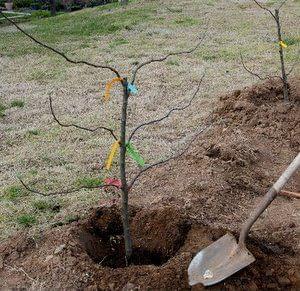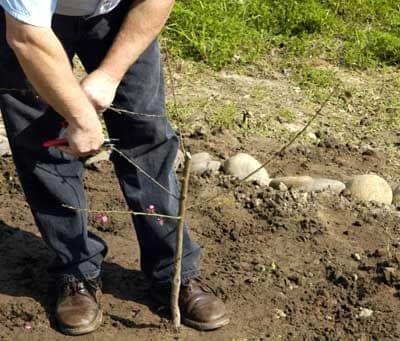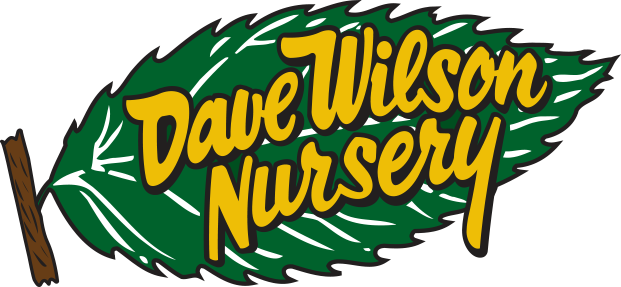We sell our products to retail nurseries, garden centers, container growers who sell to landscape contractors and retail nurseries, mail order nurseries, and anyone else who qualifies. We do not accept direct sales to consumers.
Most important: know your site's drainage.
Most fruit trees will not survive in soil that drains so slowly it remains water-saturated for extended periods. Before planting, be sure you are familiar with how well your soil drains.
Test your drainage.
Dig a hole about l foot deep and fill it with water.
If the water drains within 3 or 4 hours, fill the hole again.
If it takes longer than 3 or 4 hours to drain on the 1st or 2nd filling, you have problems!
If your intended planting site drains poorly your options are:
Don't plant there.
Plant the tree above the present soil line by constructing a berm, mound or raised bed.
Install a French Drain (a trench filled with gravel or rock that allows water to drain away from the planting area – see How To Install French Drains For Yard Drainage).
Berms and Mounds
The root crown, the upper part of the root system to just below the soil line, is the most vulnerable part of a tree. In many instances, a 6-12” high raised planting area (mound or berm) is sufficient to raise tree root crowns above wet soil. A 6-inch high mound should be at least 2 ½ feet in diameter, a 10- to 12-inch mound or berm at least 3-4 feet wide. Mounds should have as gentle a slope as possible to minimize erosion.
Raised Bed
A good way to plant trees higher than the surrounding soil is to make a bottomless box using 2x12 redwood or cedar or other material such as rock, concrete block, railroad ties, etc. (See How To Build a Raised Bed.)
Sun
For the healthiest trees and tastiest fruit choose the sunniest available planting location. The main exception is a low desert climate where summer temperatures reach 110°+; fruit trees there benefit from some afternoon shade.
Layout and Spacing
Spacing depends on your objectives, your plan - how much fruit you want from each tree, how many trees are wanted in the total space available and how you intend to control tree size. (Remember, small trees maintained by summer pruning are much easier to spray, thin, prune and harvest than large trees.)
If planting high density, plant as close as 18 inches apart for 2, 3 or 4 trees in one hole and 2 or 3 feet apart for hedgerow. (See What Is Backyard Orchard Culture? and High-Density Planting - Simple Examples.)
If you have plenty of space and want larger trees, plant at wider spacings. It's up to you.
And! Please read our articles Multi-Planting Strategies and The Art of Successive Ripening for multi-planting suggestions.
Reminder – if multi-planting, plant similar rootstocks together and trees with simliar spray requirements together. Contact your local fruit tree nursery or a Master Gardener in your area for spray recommendations.
About Planting Fruit Trees
Fertilizer
No fertilizer is needed at the time of planting a bare root tree. Furthermore, fertilizers in contact with tender young feeder roots can kill them and set back or kill the tree.
Soil Amendments
Ultimately, trees must grow in the surrounding soil. Don’t make a hole of amended soil surrounded by slow-draining native soil – the tree hole will just fill with water, killing the tree. The only remedy for poorly draining soil is some sort of raised bed or planting in containers. Adding organic matter to sandy soil, however, can help retain moisture in the root zone of newly planted trees. Check with your local fruit tree nursery regarding recommended soil amendments.
Planting Depth
When planted, the tree should be at the height it was in the nursery; the nursery soil line is visible on the trunk as a slight change in bark color. It’s very important not to plant the tree too low. If you will be watering-in the tree after planting (as you should when planting in fast-draining soil), plant an inch or two high to allow for settling.
Caring For Bare Root Trees
Bare root trees should be planted as soon as possible after purchasing. If buying trees before planting day, keep the roots wrapped or covered to maintain moisture and high humidity; store in a cool location. Bareroot trees may be held before planting by heeling in: cover the roots well with a moist (not soggy) medium such as sawdust (but not redwood or cedar), sand or porous soil. Do not let the roots dry out or freeze.
How to Plant A Fruit Tree

Dig the hole a little deeper than the root is tall — and make it wide enough to accommodate the longest roots without bending.
Loosen the sides of the hole. Roots sometimes do not readily penetrate a slick interface.
Backfill with native or slightly amended soil until the bottom of the hole is at the right planting depth for the tree. If multi-planting in one hole, backfill to correct planting depth for each tree.
Prune off any broken, rotted or twisted roots, making a clean cut.
Position the tree, spread the roots and refill the hole, tamping the soil around the roots as you go.
If planting in fast-draining soil, water thoroughly in order to finish settling the soil around the roots. In slower-draining soils, water a little at a time - over several days if necessary.
Usually, no further water is necessary until there is new growth of several inches.
Note: If there is a prevailing wind in your area that reaches your site, compensate by leaning the tree slightly into the upwind direction when you plant. The side of the tree where the scion emerges from the rootstock should be pointing upwind.
Planting in A Raised Box (See How To Build A Raised Bed)
Construct a 3 to 4 foot square box for a single tree, 5 ft. x 5 ft. for four trees in one hole.
Place the box on the poorly draining spot.
Dig a shallow hole only if necessary to allow for proper planting depth (see above). In any viable garden soil tree roots will find their own way to anchorage.
Place the tree in the box, spread the roots and fill the box with soil (slightly amended if necessary), tamping the soil around the roots as you go.
Water as needed to maintain soil moisture around the roots.
Last Steps

Pruning
If you want the fruiting wood to begin low, smaller trees may be cut back at planting time to a height as low as the knee (15-20 inches). Any remaining side limbs should be cut back to one or two buds. Larger trees may be cut above existing well-placed low limbs, or they too may be cut back low to force new, lower limbs. (See "What Is Backyard Orchard Culture? ", including the caution regarding cutting back larger sizes of peach and nectarine.)
Paint the Trunk
Sunburn can damage newly planted trees, especially in the climates of the southwestern U.S. An interior white latex, diluted 50% with water, can help protect trees from this problem. Paint your newly-planted trees from the ground all the way to the top.
Mulch!
Mulch applied as a top dressing is beneficial to plants and the soil; as mulch decomposes it provides a steady source of nutrients to plants and organic matter to the soil. And, it helps to stabilize and conserve soil moisture. (See Water and Mulch.)
Related Content
What Is Backyard Orchard Culture?
Simple Examples of High-Density Planting
